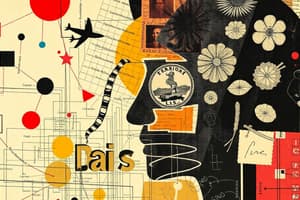Podcast
Questions and Answers
What are the two main graphic organizers techniques discussed in the content?
What are the two main graphic organizers techniques discussed in the content?
Brainstorming and Outlining
Which of these is NOT a type of brainstorming?
Which of these is NOT a type of brainstorming?
- Mind Mapping (correct)
- Idea Mapping
- Freewriting
- Idea Listing
Freewriting encourages continuous writing without worrying about grammar or spelling mistakes.
Freewriting encourages continuous writing without worrying about grammar or spelling mistakes.
True (A)
Which of these is NOT a characteristic of Generation Z?
Which of these is NOT a characteristic of Generation Z?
What is another term for Idea Mapping?
What is another term for Idea Mapping?
What is the main purpose of Graphic Organizers?
What is the main purpose of Graphic Organizers?
Graphic Organizers are only useful for academic purposes.
Graphic Organizers are only useful for academic purposes.
What is the purpose of using a Venn Diagram?
What is the purpose of using a Venn Diagram?
Match the following graphic organizers with their descriptions:
Match the following graphic organizers with their descriptions:
What is the main benefit of using a timeline?
What is the main benefit of using a timeline?
Which type of timeline shows events happening within the same period but compares two different sets of events?
Which type of timeline shows events happening within the same period but compares two different sets of events?
A plot diagram is a tool used to analyze the structure of a story by identifying key plot points.
A plot diagram is a tool used to analyze the structure of a story by identifying key plot points.
Which of these is NOT a key component of a story map?
Which of these is NOT a key component of a story map?
Tables are considered the most basic and widely used graphic organizer due to their straightforward structure.
Tables are considered the most basic and widely used graphic organizer due to their straightforward structure.
What does the acronym "KWL" stand for in the context of a KWL table?
What does the acronym "KWL" stand for in the context of a KWL table?
What is the purpose of a self-assessment checklist?
What is the purpose of a self-assessment checklist?
Concept maps depict connections and relationships between different concepts, often using a hierarchical structure.
Concept maps depict connections and relationships between different concepts, often using a hierarchical structure.
Which of these is NOT a typical component of a research concept map?
Which of these is NOT a typical component of a research concept map?
What is the primary function of a flow chart?
What is the primary function of a flow chart?
Which symbol is typically used in a flow chart to represent a decision point?
Which symbol is typically used in a flow chart to represent a decision point?
Outlining is considered the "blueprint" for a written piece because it organizes information before writing.
Outlining is considered the "blueprint" for a written piece because it organizes information before writing.
Which outlining format is generally preferred for descriptive texts?
Which outlining format is generally preferred for descriptive texts?
Which of these is NOT a principle of outlining?
Which of these is NOT a principle of outlining?
What is the key difference between a topic outline and a sentence outline?
What is the key difference between a topic outline and a sentence outline?
Adequate sleep can improve cognitive functions such as memory, concentration, and problem-solving abilities.
Adequate sleep can improve cognitive functions such as memory, concentration, and problem-solving abilities.
Which of these is a negative health outcome associated with inadequate sleep?
Which of these is a negative health outcome associated with inadequate sleep?
Flashcards
Brainstorming
Brainstorming
A technique where the writer collaborates with others to explore topics, develop ideas, and propose solutions to a problem.
Freewriting
Freewriting
A type of brainstorming where the writer continuously writes down ideas without focusing on errors in grammar or spelling.
Idea Listing
Idea Listing
A type of brainstorming where the writer lists down ideas related to a specific topic.
Idea Mapping
Idea Mapping
Signup and view all the flashcards
Graphic Organizers
Graphic Organizers
Signup and view all the flashcards
Venn Diagram
Venn Diagram
Signup and view all the flashcards
Network Tree
Network Tree
Signup and view all the flashcards
Fishbone Diagram
Fishbone Diagram
Signup and view all the flashcards
Cycle Diagram
Cycle Diagram
Signup and view all the flashcards
Series of Events Chain
Series of Events Chain
Signup and view all the flashcards
Plot Diagram
Plot Diagram
Signup and view all the flashcards
Story Map
Story Map
Signup and view all the flashcards
Concept Map
Concept Map
Signup and view all the flashcards
Flow Chart
Flow Chart
Signup and view all the flashcards
Timeline
Timeline
Signup and view all the flashcards
Outlining
Outlining
Signup and view all the flashcards
Alphanumeric Outlining
Alphanumeric Outlining
Signup and view all the flashcards
Decimal Outlining
Decimal Outlining
Signup and view all the flashcards
Coordination in Outlining
Coordination in Outlining
Signup and view all the flashcards
Subordination in Outlining
Subordination in Outlining
Signup and view all the flashcards
Division in Outlining
Division in Outlining
Signup and view all the flashcards
Parallel Construction in Outlining
Parallel Construction in Outlining
Signup and view all the flashcards
Sentence Outline
Sentence Outline
Signup and view all the flashcards
Topic Outline
Topic Outline
Signup and view all the flashcards
Table
Table
Signup and view all the flashcards
Self-Assessment Checklist
Self-Assessment Checklist
Signup and view all the flashcards
Impromptu Speech
Impromptu Speech
Signup and view all the flashcards
Memorize Speech
Memorize Speech
Signup and view all the flashcards
Oral Communication
Oral Communication
Signup and view all the flashcards
Study Notes
Techniques in Selecting and Organizing Information
- Objectives:
- Distinguish between approaches for selecting and organizing information.
- Practice necessary outlining for a writing topic.
- Use different graphic organizers for selecting and organizing information.
Brainstorming
- A collaborative process where writers explore topics, develop ideas, and propose solutions to problems.
- Every participant writes any ideas, suggestions, and thoughts related to the topic.
- Includes various types such as freewriting, idea listing, and idea mapping.
Freewriting
- Continuous writing without inhibitions or concern for errors.
- Focuses on generating ideas and thoughts as they occur.
- Serves as a tool for generating ideas for a writing topic.
Idea Listing
- Listing all ideas or concepts that come to mind in relation to a topic.
- E.g., listing ideas related to unemployment or to Generation Z.
- Useful for coming up with a topic to write about.
Idea Mapping
- Visual representation of ideas and their connections to one another.
- Also known as web clustering.
- Helps visualize relationships between ideas.
Graphic Organizers
- Visual representations of relationships between themes.
- Consist of various forms like tables, graphs, and charts.
- Useful to present information in a structured way to enhance comprehension.
- Examples include: Main Idea to Detail, Biography Map, Scientific Method, Fishbone Planner, Fact or Opinion, Read It, Say It, Write It, Vocabulary word, Two Stors & A Wish, Word Web
Venn Diagram
- Uses overlapping circles to compare and contrast ideas and events.
Network Tree
- Depicts relationships among categories and lineages to show classification, branching, and hierarchy.
- Useful to present a visual map of many items.
Fishbone Diagram
- Used to understand causal relationships of complex phenomena.
- Shows factors that cause a specific event or problem.
Cycle
- Describes a series of events that interact to produce repeated results.
- Depicts cyclical patterns between events.
Timeline
- Shows specific events in sequence, often including dates.
- Represents events in a linear fashion.
- Distinguishes between linear and comparative timelines.
Story Map
- A graphic organizer for identifying elements of literature (characters, plot, setting).
Table
- The simplest and most widely used graphic organizer.
- Comprised of rows and columns for organizing data.
Self-Assessment Checklist
- A table with columns such as "Task", "Completed", "In Progress", and "Comments"
- Used for tracking tasks needed for examinations.
Concept Map
- Depicts the relationships between concepts.
Flow Chart
- Used to show the chronology of events or stages in a process. Includes various shapes (rectangles, diamonds, ovals).
Essay Outline
- Can be alphanumeric or decimal format. Guides the development of an essay by demonstrating structure. Different formats help you structure an essay into a topic outline or a sentence outline.
Studying That Suits You
Use AI to generate personalized quizzes and flashcards to suit your learning preferences.




